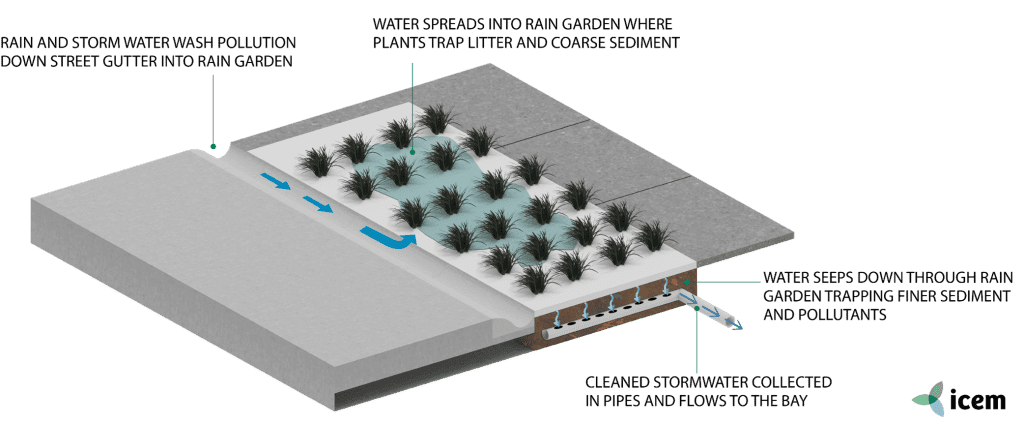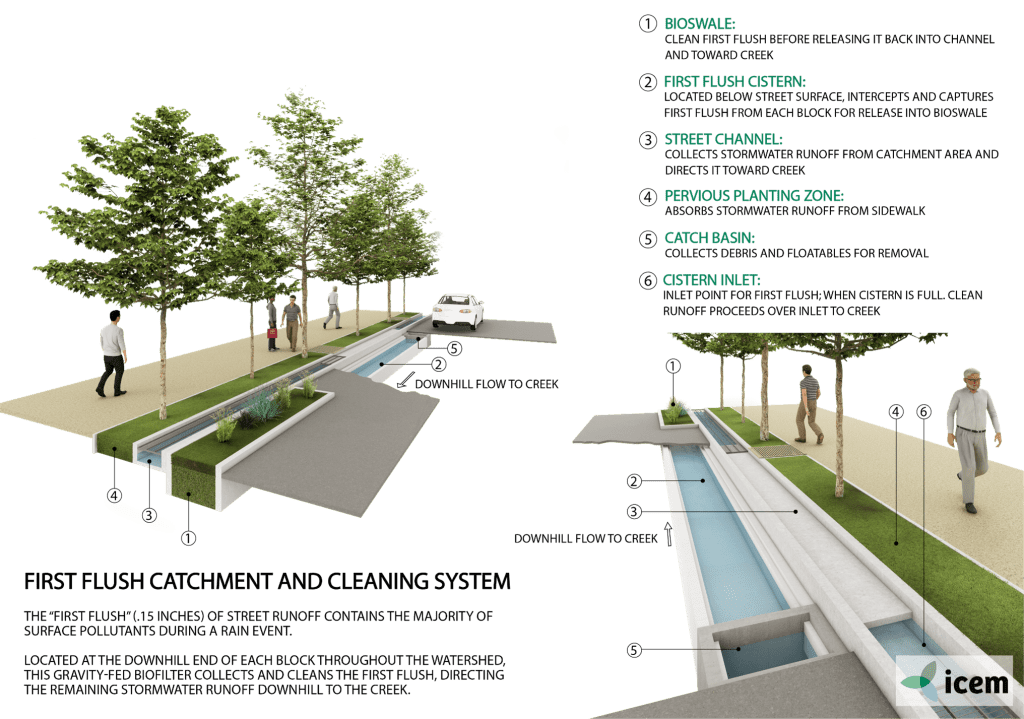| Suburban | River | Medium-cost | Pluvial/fluvial flooding | |
| DESCRIPTION | ||||||||||
| Measures
|
Bioretention swales are vegetated swales with the addition of a sub-surface filter and a slotted collector pipe. The surface vegetation in the swale promotes uniform flow and also slows the water velocity to encourage the settlement of courser sediments while the filter media and the organisms that grow in it absorb pollutants, thus improving the overall effectiveness. During frequently occurring low-flow events stormwater is filtered through the filter material, providing both physical and biological treatment, while after heavy rainfall most of the flow is carried within the swale.
Bioretention is a versatile stormwater practice that filters runoff through plants, an engineered soil mix, and often an underdrain. Bioretention can be used to: ● To manage the first 2.5 centimeters of rainfall on-site using an infiltration design with no underdrain; ● To reduce pollutant loads to meet water-quality targets (total maximum: loads or TMDLs) ● To retrofit existing developed areas, especially highly impervious areas; |
|||||||||
| Location | Bioretention swales are suited to urbanized areas and can be incorporated as a boundary-defining feature or landscape element in parks or located within medians of roads, depots or car parks. Bioretention has various forms that inform the ideal location:
● Water quality swale: linear and narrower applications, often with a longitudinal slope; with check dams to break to swale in “cells,” and being covered with turf, herbaceous plants, or other surface material. The design specifications for water quality swales are the same as for bioretention, except for the additional information contained within this section ● Urban bioretention: adaptations for highly impervious settings; including street bioretention, engineered tree pits, and stormwater planters; ● Residential rain garden: simplified version designed for residential yards are small-scale applications. |
|||||||||
| Design options and performance | The bioretention swale provides pre-treatment (removal of sediments) of stormwater before it enters the bioretention component of the system. There are two possible design configurations for bioretention swales. The bioretention component can be located at the downstream end of the swale or provided as a continuous ‘trench’ along the full length of a swale. When used as a continuous trench along the full length of a swale, the desirable maximum longitudinal grade of the swale is not greater than 4%. The choice of bioretention location within the overlying swale will depend on several factors, including the area available for the bioretention filter media and the maximum batter slopes for the overlying swale. If the bioretention element is at the downstream end of the swale the desirable grade of the bioretention zone is either horizontal or as flat as possible to encourage the uniform distribution of stormwater flows over the full surface area of bioretention filter media and to allow temporary storage of flows (extended detention) for treatment before bypass occurs. | |||||||||
| Feasibility criteria
|
Technical design: The components of a bioretention swale are:
● Surface vegetation consisting of water-tolerant plants or grasses ● 30 to 70 cm layer of sandy loam soil for the filter layer ● 10 cm transition layer of coarse sand ● 15 to 20 cm drainage layer of fine aggregate. Soil media: the soil media is the most important element of a bioretention facility in terms of long-term performance. The recommended bioretention soil mixture is generally classified as loamy sand on the USDA texture triangle, with the following composition: ● 70% to 88% sand ● 8% to 26% topsoil ● 3% to 5% organic matter Guidance for using underdrains
Soil slope: less than 4% Surface cover: Vegetation should be selected based on local climate and rainfall regime, be of sufficient density, and be maintained at a height above the treatment flow level to maximize filtration. Mulch: a 5.1-7.6 cm layer of mulch on the surface of the filter bed enhances plant survival, suppresses weed growth and pre-treats runoff before it reaches filter media. Materials: Equipment for excavation, sandy loam soil for filter media, coarse sand for transition layer, fine aggregate for drainage layer, pipework and plants. |
|||||||||
| Operation and maintenance | Bioretention swales usually require very little maintenance but they must be properly sized and vegetated. If the filter material becomes compacted or blocked, replacement of both the vegetation and filter material will be required. Removal of litter and organic matter will be required if they are placed in high litter load areas. | |||||||||
| Cost and benefits | Bioretention swales are a medium cost measure and have a comparable construction cost to piped systems. Bioretention swales capture and attenuate frequent flow events as stormwater is filtered through the system thus reducing the peak volume of stormwater entering waterways and stormwater networks. They also provide treatment of stormwater, targeting fine sediments, metals, particulate and dissolved nutrients and can achieve best practice pollutant load reductions when sized correctly. | |||||||||
| Design solution
|
A bioretention swale has a bioretention system located within its base to fulfil the following functions:
● Provide a conveyance function. ● Remove fine and coarse sediments. ● Remove hydrocarbons and other soluble or fine particulate contaminants from biological uptake. ● Provide a low level of extended detention. ● Provide flow retardation for frequent (low ARI) rainfall events. The swale component provides pre-treatment of stormwater to remove coarse to medium sediments while the bioretention system removes finer particulates and associated contaminants. |
|||||||||
| Environmental performance | Swales can support a wide range of plantings to increase beneficial habitat and green scape. Swales also provide flexibility for planting a variety of street trees on the bottom, on side slopes, or at raised berms between cells. | |||||||||
| Sources | ● CIRIA. 2015. The SuDS Manual. Chapter 18, Bioretention Systems.
● Derwent Estuary. Not dated. WSUD procedures for stormwater management. Chapter 4: Bioretention Swales. ● Melbourne Water. 2005. WSUD Engineering Procedures: Stormwater. |
|||||||||
Originally developed under the ADB ‘TA-9417 VIE: Secondary Green Cities Development Project – Output 2: Demonstrated sustainable and resilient development in Hue, Ha Giang and Vinh Yen’. Adapted for the UN-CTCN project ‘Climate risk assessment for subnational adaptation and establishment of a local climate information system for climate change adaptation (LISA) in Cambodia’.




